 It’s an oft-trotted out cliche that 2-0 is the most dangerous score line in football. The feeling seems to be that the attacking team doesn’t know whether to stick with what they’ve got or keep attacking in the hope of furthering their lead, whilst for the defensive side the idea that the worst possible thing has already happened means that they have some freedom to attack. Whether the saying is true or not is an entirely different matter.
It’s an oft-trotted out cliche that 2-0 is the most dangerous score line in football. The feeling seems to be that the attacking team doesn’t know whether to stick with what they’ve got or keep attacking in the hope of furthering their lead, whilst for the defensive side the idea that the worst possible thing has already happened means that they have some freedom to attack. Whether the saying is true or not is an entirely different matter.
It’s also fair to wonder whether being 5-3 down is the same as losing 2-0. Does the fact that it’s clearly such an open game mean that the chances of the team with three goals scoring two more are higher than if they were yet to get on the score sheet? Is being two goals clear actually a dangerous score line, or is it just in the psyche that people fear for the worst because of freak previous results? We’ll have a look here.
How Often Do Premier League Teams Lose A 2 Goal Lead?
In the five seasons between 2015/16 and 2019/20, Premier League teams took a two goal lead in 947 matches. Of those, 887 (93.7%) won that game, 40 (4.2%) were drawn, and 20 (2.1%) lost the match.
Across this period there were 813 games where a team took a 2-0 lead. Of these matches, 756 (93%) won at full-time, 41 (5%) were drawn, and 16 (2%) lost.
Is Two-Nil A Dangerous Score Line?
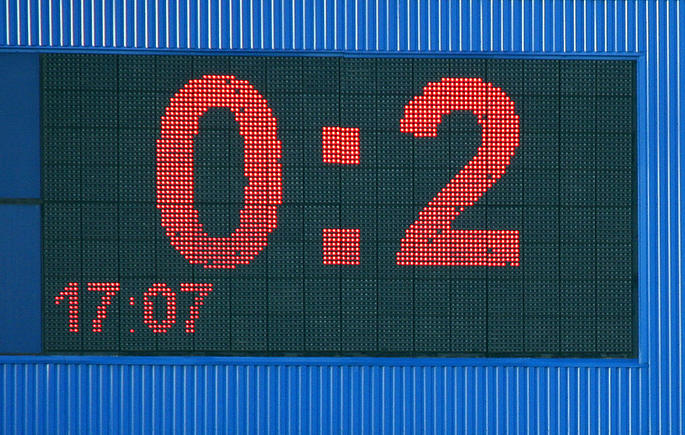
Whilst this article is all about being two goals clear rather than about being 2-0 up specifically, it’s handy to take a quick look at the psychology behind the idea that 2-0 is a dangerous score line in football matches. Does it increase complacency in the team that has taken the lead, resulting in an assumption that the result is as good as in the bag? According to OptaJoe, a statistical analysis site, only 2.1% of teams leading 2-0 at half-time have gone on to lose the game.
22 – There have been 1061 previous occasions of a team being 2-0 ahead at HT in the PL; only 22 have lost from that position (2.1%). Answer. https://t.co/CKwrMyWOuZ
— OptaJoe (@OptaJoe) December 4, 2016
Obviously that doesn’t take into account a side taking a 2-0 lead at another point during a match and losing, nor does it make clear what happens to sides leading 2-0 and drawing the game from that position. Instead, the work from OptaJoe highlighted the 1061 occasions a Premier League team had been 2-0 up at half-time and then lost up to early December of 2016. Even so, 2.1% is a much lower statistic than many would have expected given the cliche.
In the three seasons between 2017/18 and 2019/20, there have been 495 two-nil leads during Premier League matches. Of those, only 22 (4.4%) resulted in draws and only 9 (1.8%) where turned around into defeats.
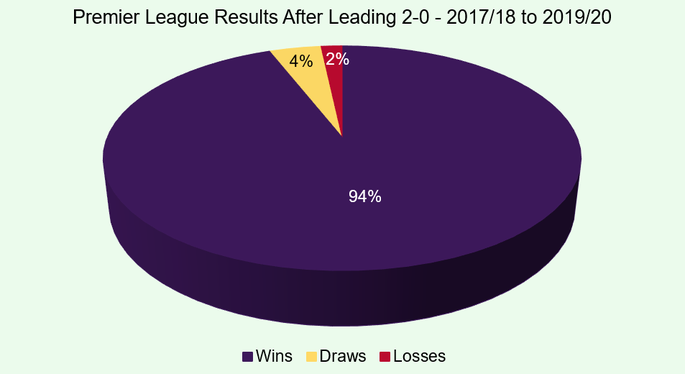
The question, then, becomes about why the cliche exists in the first place. It’s likely that there are two sets of people that use it, with one of them being the reason for its prevalence. Managers and football coaches will almost certainly tell their teams that 2-0 is a dangerous score line in order to get them to focus on the second-half. Yet it’s commentators and football pundits saying it in order to maintain an audience’s interest that is likely to result in people believing it’s true.
At the end of the day, it is the job of pundits and commentators to keep an audience tuned in to a football match, with lost audiences meaning lost revenue. If a team goes 2-0 up then most of the audience will assume that the match is a done deal and switch off. Getting them to imagine that the match is still live will keep them tuned in to see if anything can be gained by the losing team becoming more attacking.
What About A Two Goal Advantage?

The above is taking a specific look at 2-0 score lines, but what about when a team is two goals clear at some point during a match? The idea is that a team that is one goal clear will be more focussed than one with a two goal lead, owing to the latter feeling more secure. Then, if the losing team scores one goal then they’ll start to gain a bit of confidence and belief whilst the team that was in the lead will start to fear the worst. But is that really true?
If we were to look at all the times that a team had had a two goal advantage between the dawn of the Premier League and the end of the 2016-2017 season, a team took a two goal lead on over 2700 occasions. Of those, around 90% ended up in wins for the team that took the lead, whilst around 7.5% ended in a draw. Just over 2.5% of two goal leads resulted in the team that had been losing going on to win the match.
It’s fair to say, then, that the idea of a two goal lead being a dangerous one is a complete nonsense. It’s simply not true, with matches far more likely to witness an own-goal being scored than a two goal lead thrown away.
If we look at the five most recent completed seasons between 2015/16 and 2019/20, teams took a two goal lead on 947 occasions, winning the match in 887 of those (93.66%), drawing on 40 occasions (4.22%) and losing on just 20 occasions (2.11%).
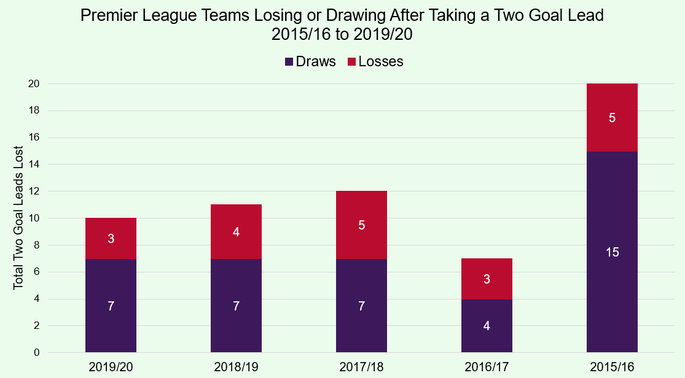
The tables below show all instances of a team losing a two goal lead in each of these five seasons.
Premier League Teams Losing a Two Goal Lead – 2019/20
| Date | Team | Opponent | Lead | Result |
|---|---|---|---|---|
| 31/08/2019 | Chelsea (H) | Sheffield United (A) | 2-0 | 2-2 Draw |
| 01/09/2019 | Tottenham Hotspur (A) | Arsenal (H) | 0-2 | 2-2 Draw |
| 15/09/2019 | Arsenal (A) | Watford (H) | 0-2 | 2-2 Draw |
| 27/10/2029 | Arsenal (H) | Crystal Palace (A) | 2-0 | 2-2 Draw |
| 24/11/2019 | Sheffield United (H) | Manchester United (A) | 2-0 | 3-3 Draw |
| 27/12/2019 | Manchester City (A) | Wolverhampton Wanderers (H) | 0-2 | 3-2 Loss |
| 18/01/2020 | Southampton (H) | Wolverhampton Wanderers (A) | 2-0 | 3-2 Loss |
| 21/01/2020 | Everton (H) | Newcastle United (A) | 2-0 | 2-2 Draw |
| 01/02/2020 | Watford (H) | Everton (A) | 2-0 | 3-2 Loss |
| 01/02/2020 | West Ham United (H) | Brighton & Hove Albion (A) | 2-0 | 3-3 Draw |
Premier League Teams Losing a Two Goal Lead – 2018/19
| Date | Team | Opponent | Lead | Result |
|---|---|---|---|---|
| 25/08/2018 | Everton (A) | Bournemouth (H) | 0-2 | 2-2 Draw |
| 01/09/2018 | Fulham (A) | Brighton & Hove Albion (H) | 0-2 | 2-2 Draw |
| 17/09/2018 | Southampton (H) | Brighton & Hove Albion (A) | 2-0 | 2-2 Draw |
| 06/10/2018 | Newcastle United (A) | Manchester United (H) | 0-2 | 3-2 Loss |
| 01/12/2018 | Southampton (H) | Manchester United (A) | 2-0 | 2-2 Draw |
| 02/01/2019 | Watford (A) | Bournemouth (H) | 0-2 | 3-3 Draw |
| 02/01/2019 | Brighton & Hove Albion (A) | West Ham United (H) | 0-2 | 2-2 Draw |
| 29/01/2019 | Brighton & Hove Albion (A) | Fulham (H) | 0-2 | 4-2 Loss |
| 29/01/2019 | Burnley (A) | Manchester United (H) | 0-2 | 2-2 Draw |
| 09/03/2019 | Everton (A) | Newcastle United (H) | 0-2 | 3-2 Loss |
| 16/03/2019 | Huddersfield Town (A) | West Ham United (H) | 1-3 | 4-3 Loss |
Premier League Teams Losing a Two Goal Lead – 2017/18
| Date | Team | Opponent | Lead | Result |
|---|---|---|---|---|
| 28/10/2017 | West Ham United (A) | Crystal Palace (H) | 0-2 | 2-2 Draw |
| 05/11/2017 | Watford (A) | Everton (H) | 0-2 | 3-2 Loss |
| 28/11/2017 | West Bromwich Albion (H) | Newcastle United (A) | 2-0 | 2-2 Draw |
| 22/12/2017 | Liverpool (A) | Arsenal (H) | 0-2 | 3-3 Draw |
| 26/12/2017 | Burnley (A) | Manchester United (H) | 0-2 | 2-2 Draw |
| 13/01/2018 | Southampton (A) | Watford (H) | 0-2 | 2-2 Draw |
| 24/02/2018 | Newcastle United (A) | Bournemouth (H) | 0-2 | 2-2 Draw |
| 05/03/2018 | Crystal Palace (H) | Manchester United (A) | 2-0 | 3-2 Loss |
| 07/04/2018 | Manchester City (H) | Manchester United (A) | 2-0 | 3-2 Loss |
| 14/04/2018 | Southampton (H) | Chelsea (A) | 2-0 | 3-2 Loss |
| 21/04/2018 | Liverpool (A) | West Bromwich Albion (H) | 0-2 | 2-2 Draw |
| 13/05/2018 | Leicester City (A) | Tottenham Hotspur (H) | 1-3 | 5-4 Loss |
Premier League Teams Losing a Two Goal Lead – 2016/17
| Date | Team | Opponent | Lead | Result |
|---|---|---|---|---|
| 10/09/2016 | West Ham United (H) | Watford (A) | 2-0 | 4-2 Loss |
| 24/09/2016 | Sunderland (H) | Crystal Palace (A) | 2-0 | 3-2 Loss |
| 04/12/2016 | Liverpool (A) | Bournemouth (H) | 0-2 | 4-3 Loss |
| 17/12/2016 | Stoke City (H) | Leicester City (A) | 2-0 | 2-2 Draw |
| 03/01/2017 | Bournemouth (H) | Arsenal (A) | 3-0 | 3-3 Draw |
| 21/01/2017 | Manchester City (H) | Tottenham Hotspur (A) | 2-0 | 2-2 Draw |
| 15/04/2017 | Leicester City (A) | Crystal Palace (H) | 0-2 | 2-2 Draw |
Premier League Teams Losing a Two Goal Lead – 2015/16
| Date | Team | Opponent | Lead | Result |
|---|---|---|---|---|
| 15/08/2015 | Tottenham Hotspur (H) | Stoke City (A) | 2-0 | 2-2 Draw |
| 13/09/2015 | Aston Villa (A) | Leicester City (H) | 0-2 | 3-2 Loss |
| 19/09/2015 | Stoke City (H) | Leicester City (A) | 2-0 | 2-2 Draw |
| 26/09/2015 | Newcastle United (H) | Chelsea (A) | 2-0 | 2-2 Draw |
| 28/09/2015 | West Bromwich Albion (H) | Everton (A) | 2-0 | 3-2 Loss |
| 03/10/2015 | Sunderland (H) | West Ham United (A) | 2-0 | 2-2 Draw |
| 17/10/2015 | Southampton (H) | Leicester City (A) | 2-0 | 2-2 Draw |
| 21/11/2015 | Bournemouth (A) | Swansea City (H) | 0-2 | 2-2 Draw |
| 28/11/2015 | Everton (A) | Bournemouth (H) | 0-2 | 3-3 Draw |
| 12/01/2016 | Manchester United (A) | Newcastle United (A) | 0-2 | 3-3 Draw |
| 16/01/2016 | Everton (A) | Chelsea (H) | 0-2 | 3-3 Draw |
| 23/01/2016 | Norwich City (H) | Liverpool (A) | 3-1 | 5-4 Loss |
| 06/02/2016 | Liverpool (H) | Sunderland (A) | 2-0 | 2-2 Draw |
| 13/02/2016 | Norwich City (H) | Southampton (A) | 2-0 | 2-2 Draw |
| 05/03/2016 | Everton (H) | West Ham United (A) | 2-0 | 3-2 Loss |
| 20/03/2016 | Liverpool (A) | Southampton (H) | 0-2 | 3-2 Loss |
| 02/04/2016 | Stoke City (H) | Swansea City (A) | 2-0 | 2-2 Draw |
| 09/04/2016 | Arsenal (A) | West Ham United (H) | 0-2 | 3-3 Draw |
| 23/04/2016 | Liverpool (H) | Newcastle United (A) | 2-0 | 2-2 Draw |
| 02/05/2016 | Tottenham Hotspur (A) | Chelsea (H) | 0-2 | 2-2 Draw |
Which Teams Have Lost the Most Two Goal Leads?
The tables above show that the biggest culprits in losing a two goal lead between 2015/16 and 2019/20 are Everton, Liverpool and Southampton, who have lost a two goal lead and failed to win on six occasions each. All three teams lost twice and drew four times. They are followed by Manchester City and Watford (both two losses and one draw), Newcastle United and West Ham United (both one loss and two draws), and Arsenal, Stoke City and Tottenham Hotspur (all three draws).
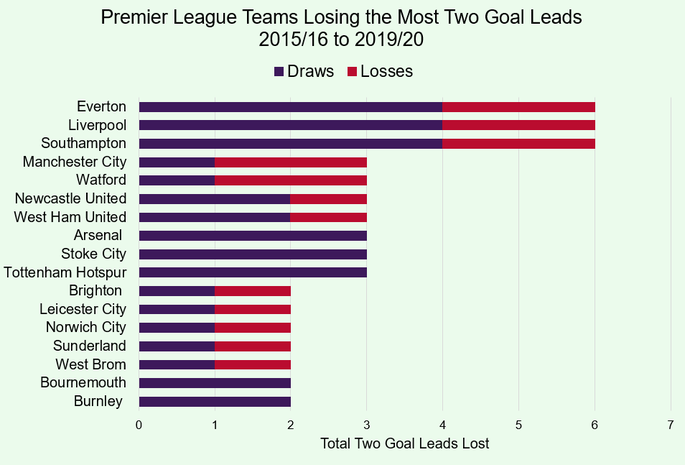
Which Teams Have Overturned the Most Two Goal Deficits?
In terms of overturning a two goal deficit between 2015/16 and 2019/20, Manchester United are the comeback kings winning three times and drawing four times having been two goals down. Bournemouth and Newcastle United are next best with one win and four draws each, followed by Crystal Palace, Leicester City and West Ham United who have all earned one win and three draws having been two goals adrift in matches. Interestingly, three of Leicester City’s four comebacks came in their title winning season of 2015/16.
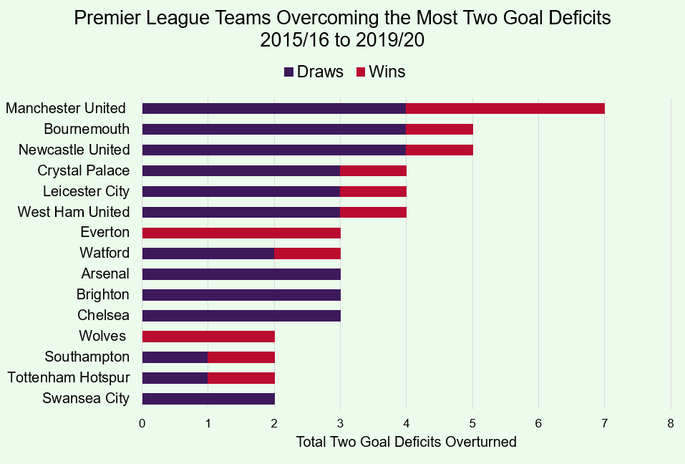
What Score Line Is Dangerous?

If a two goal lead is only likely to be thrown away a little over 2% of the time, which score line is actually a dangerous one? Well, it won’t come as much of a surprise to learn that a one goal lead is a score line far more likely to result in dropped points than being two goals clear of the opposition. Between the start of the Premier League era and the end of the 2016-2017 campaign, a team was one goal clear over 5,700 times. Only around 3000 went on to win the game.
That means that just over 52% of teams that were one goal clear went on to win their match. Given that more than 1,700 of those games ended in a draw, that’s around 30% of one goal leads that resulted in dropped points. Just under 1000 of those games went on to be won by the team that was trailing, or just over 17% of the matches. To put it another way, if a team is one goal clear than they’re almost 38% less likely to go on and win the game than a team with a two goal advantage.
Teams that go three goals clear, meanwhile, will go on to win more than 98% of them time. That’s based on over 1100 teams that scored three more goals than their opponents in Premier League matches between 1992 and 2017. Of those matches that featured a three goal lead, only sixteen matches ended in a draw and just four resulted in a win for the team that had been trailing. That’s only 0.4% of wins for teams that faced a three goal deficit.
Where Did the Idea of the Dangerous Lead Originate?

Now that we know that a two goal lead is not even remotely dangerous, statistically speaking, the obvious question to ask is where the cliche came from on the first place. Obviously it’s difficult to narrow down exactly how a cliche becomes part of modern terminology, with the most likely explanation being that some high-profile results have happened over the years and have stuck in the memories of the football watching public.
What we can say with a degree of certainty is that the notion of 2-0 specifically being a dangerous score line appears to have emerged from the Czech Republic. A television commentator in the country named Josef Csaplár, who was also a former football coach, used to say it regularly when a team went a couple of goals in front during a football match. Indeed, he said it so often that it earned the moniker of being “Csaplár’s trap”.
Famous Comebacks
Of course, it’s not as if there haven’t been a host of famous matches over the years in which a team has raced into a healthy lead only to see it vanquished before the full-time whistle.
West Germany 3 – 2 Hungary, June 1954
During the 1950s, Hungary were considered to be one of the best teams on the planet, losing just one match between May 1950 and February 1956. It just so happens that the match that they did lose was one in which they went 2-0 up.
Having beaten West Germany 8-3 during the group state of the 1954 World Cup, the Hungarians were confident of winning the trophy when they faced the Germans again in the final. Goodness knows how much money people would have been betting on them in the modern day when they went 2-0 up, only for West Germany to complete the Wunder von Bern by winning 3-2 and being declared world champions for the first time in the country’s history.
Manchester City 2 – 3 Manchester United, April 2018
Even modern football can’t escape the clutches of a good story that plays into a cliche. So it is that Manchester City played host to Manchester United at the Etihad towards the end of the 2017-2018 season, knowing that victory would see them declared Premier League champions. First-half goals from Vincent Kompany and Ilkay Gundogan saw the Cityzens race into a 2-0 lead and prepare to celebrate in front of their most bitter rivals.
The second-half was anything but a procession, however, with Paul Pogba scoring two goals in two minute and Chis Smalling netting the winner for José Mourinho’s side, ensuring that the cliche lived to fight another day. That Manchester United ending up finishing nineteen points off the top when the season reached its conclusion didn’t seem to dampen the spirits of United fans, who delayed their neighbours’ title win, even if only for a week or so.
